- Home
- William H. Keith
Symbionts Page 18
Symbionts Read online
Page 18
“Yes, sir.”
“Have your people start analyzing the data in ViRsim,” he told Duryea. “If you find anything more of tactical significance, patch through to me in Ops and download it, fast.”
“Absolutely, sir.” He sensed the man’s grin. “That includes any DalRiss stuff we find?”
“Especially any DalRiss stuff,” Dev replied. That, he realized, was partly what was nagging at him. The DalRiss had enormous cities, vast living structures of unknown purpose… hell, they had starships, weirdly shaped hulks a kilometer or more long. Where were they?
So far, there was nothing to indicate that there were any DalRiss left on the planet at all.
The Imperial squadron was clearly in serious trouble from the start, if only because the Confederation’s Eagle was half again larger and carried more than twice the mass of either Asagiri or Naginata. Eagle’s laser and particle accelerator batteries were more powerful and had greater range, and the big Confederation destroyer’s fire control systems allowed her to remote link with many more teleoperated missiles at a time, Since space combat was basically a matter of overwhelming the enemy’s defenses with sheer, raw firepower, the Confederation force possessed an enormous initial advantage.
On the other hand, advantage in space combat could be fleeting. Eagle was certain to be identified as the most dangerous of the Confederation warships approaching ShraRish, and she would be targeted accordingly. The Imperials could afford to ignore the frigates, corvettes, and converted freighters for a time in an all-or-nothing attempt to knock Eagle out of the fight. Constellation would be targeted next, but if the Asagiri and the Naginata could destroy or cripple Eagle without suffering critical damage themselves, they would have the Confederation light destroyer at a two-to-one advantage in mass and firepower; the rest of the rebel fleet could be mopped up more or less at the Japanese squadron commander’s leisure.
He was Shosho Kenji Hattori, a thirty-eight-year Imperial Navy veteran in command of His Majesty’s Alyan Contingent. He was kokkyojin, a “Frontier-person,” meaning he was Japanese, but born and raised off Earth. Originally from the Nihonjin colony world of Ebisu, he tended to be direct and less than subtle, with a bluntness that frequently bordered on rudeness. His Frontier manners had won him few friends within the Imperial nobility, and he was proud that he’d earned his present rank—the equivalent of rear admiral—through merit and sheer bullheaded tenacity. His family had been ocean nomads; Ebisu, named for the ancient Japanese god of fisherfolk, was largely ocean, with scatterings of islands and island continents and the floating city-ships of its colonists. When, at age twenty, Hattori had been sent to Japan to complete his education, it was only natural that the seafaring tradition in his blood find outlet with the Imperial Navy, navigating the seas of space and the K-T Plenum instead of the immense, hurricane-scoured oceans of Ebisu.
From his vantage point within the Battle Ops simulation aboard the light destroyer Naginata, Hattori had watched the rebels’ approach with interest. Some of those ships matched the description of vessels reported to have attacked the Imperial shipyards at Daikoku; if they were the same, that one that looked like a tanker would actually be a carrier, with several squadrons of warflyers loaded aboard. The armed transport would be carrying the rebel ground troops.
The transport. Kill it, and the whole point of the rebel attack would collapse.
The rebels could have no reason for being here other than a landing. Presumably, they’d somehow learned of the trouble at ShraRish and had come hoping to exploit it. Hattori smiled to himself at the thought. Knowing what the enemy wanted in a battle was more than half of his defeat. It gave the planning of this battle a Zen-like simplicity and economy of purpose. That big Amatukaze-class destroyer—he thought it must be the Tokitukaze, the ship captured by the rebels at the Battle of Eridu. She was the key to the rebel formation. The light destroyer, corvettes, and frigates were no match for the Imperial squadron without the Amatukaze destroyer backing them up; the space wing aboard that converted carrier would be warflyers for the most part, and no match for the advanced interceptors carried by Naginata and Asagiri.
So, destroy the large rebel destroyer while using fighters to fend off harrying attacks by enemy warflyers, and then go for the transport.
That was Hattori’s preferred approach in all things… simple, blunt, and brutally direct.
“All ships!” he commanded, speaking over the Japanese squadron’s primary tactical channel. “This is Hattori. Take formation One! Target on the big Amatukaze. Susume!”
The two battlefleets closed rapidly.
Chapter 16
Modern space combat can be broken into three major phases, the approach, the long-range battle, and the close-range battle.
The approach: the two respective forces are too distant to affect one another save by extremely long-ranged teleoperated missiles. The time is spent arranging the formation for maximum effect, to circumvent expected enemy strategies through tactical deployment, cloudscreens, and last-minute maneuver.
The long-range battle: at ranges of between one hundred thousand and one thousand kilometers, high-G missiles are the only effective weapon, though these can be countered by the point defense lasers (PDL) of target ships. The emphasis here is to overwhelm the targets’ defenses with saturation bombardment.…
—Strategy and Tactics of Space Warfare
Imperial Naval War College
Kyoto, Nihon
C.E. 2530
Dev knew that the Imperial commander would have to take out Eagle before attempting anything else. She was too big to ignore, too powerful to pin or block with anything less than his entire squadron. Once Eagle was crippled, he would almost certainly attack Vindemiatrix. Since Mirach hadn’t yet arrived in-system, the Trixie would be the only ship capable of carrying large numbers of troops. Her destruction wouldn’t necessarily protect Imperial troops on the surface of ShraRish—a prolonged and pinpoint bombardment from orbit would wipe them out sooner or later without ever needing to land troops—but if the rebels wanted anything in this system more than simply annihilating the Imperial forces, they would need troops. He’d strongly considered leaving the Trixie at the outer fringes of the system with the unarmed freighters. His decision to bring her along had been almost instinctive, bom partly of the knowledge that he would need every ship-mounted weapon available in this fight, but more of the knowledge that her presence would give a shape and a form to the coming battle that it wouldn’t otherwise have had. Including her in his line of battle was equivalent to a warstrider commander choosing the ground for a batde; it gave him the considerable advantage of knowing where the enemy had to attack and how he would have to maneuver to get there. For the opening few moves of the contest, Dev would know what his opponent was thinking.
With the familiar gallop of combat linkage drumming through his awareness, Dev felt nothing for the men and women waiting out the battle, helpless within the Trixie’s thin-skinned hull.
The tactics needed to crush the Imperial force spread themselves out in his mind with crystalline clarity. To counter the expected Japanese strategy, the Confederation squadron would go in head-on in a spear-shaped formation. The first shock would be taken by the point, a three-sided pyramid, with Constellation at the apex and Valiant, Audacious, and Rebel at the three corners of the base. A thousand kilometers behind them would be four of Tarazed’s six warflyer squadrons, followed by Tarazed herself. Eagle would be the spear’s shaft, hanging well back, using her longer-ranged weapons to strike the enemy at a distance, while Vindemiatrix took up station even farther astern, but positioned so that she could move up and tuck herself in close to Eagle for protection if any Imperial leakers broke through.
And they would break through. The key to this type of space naval battle, with the opposing forces on opposing courses and closing head-on was to do as much damage when the two forces interpenetrated as possible.
With six ships in his command, the Imperial CO had cho
sen an octahedral formation, placing his two destroyers in line ahead, positioning the four smaller ships at the remaining four corners halfway between them. It was, Dev had to admit as he studied the approaching formation through the tactical sim, a good choice, probably the best possible given the Imperials’ disadvantage in numbers. It concentrated his strongest units along the axis of the Confederation squadron and ensured that the smaller ships were well placed for maximum mutual support.
And after that there was nothing to do but wait.
It was a fact of modern combat that the troops—whether fighter pilots like Vandis, or striderjacks, or even legger infantry in combat armor—had at their command far more information about what was actually going on around them than had their predecessors throughout history. Direct data feeds and downloads gave them up-to-the-second information on the positions of friendly and hostile forces, gave them superbly detailed views of the fighting, allowed officers to see what their troops were seeing, permitted frontline troops to request artillery or air support and have it delivered with an accuracy that would have seemed magical to soldiers of even just a few centuries before.
The problem—one that had plagued all of humankind since the beginnings of the Information Age five centuries before—was that often there was simply too much available information. A general in command of an army, or an admiral commanding a fleet, was expected to see the big picture without becoming entangled in the fussy detail of managing the battle at the level of individual squads, platoons, or ships. A single striderjack, on the other hand, or the pilot jacked into a warflyer or the legger crouched in a trench, didn’t need to know how his decisions and actions fit into an entire, sprawling battle involving tens or hundreds of thousands of other people; indeed, it was usually desirable that he not be aware of more than his immediate responsibilities. More than once in the past, democratically run armies had faced disaster when the soldiers decided to vote on whether or not a suicide attack or a last-ditch defense or even participation in a war was really necessary.
How much to tell the troops about a given tactical or strategic situation was one of the great ethical dilemmas of modem warfare. The technology was such that individuals like Sublieutenant Vandis could watch the entire battle unfold within their cephlinked reality. In general, and within the limits imposed by the need for security, the Confederation military was more liberal with the information it allowed its troops to have than was the Imperium, which preferred to ration battle management information to its troops with rigid and miserly precision. Often, this had worked to the Confederation’s advantage—as when Dev Cameron had for purposes of propaganda and disinformation bluffed a Japanese escort captain into believing that he was a UV Cetan.
For the moment, at least, Sublieutenant Vandis had access to very nearly as much information as had Commodore Cameron. He lay within the padded coffin of his Warhawk’s slot, watching the battle unfold with the superbly sharp and crisp detail of a full cephlinked download in his mind. Acceleration had ceased some time ago and Tarazed was in free-fall, but Van felt the weightlessness no more than he’d noticed the 2 Gs after jacking in.
Van’sGuard had been lowered into a launch tube and locked in, chambered like an eighteen-ton shell in the breech of some gigantic cannon. Though he could have maintained the feed from the probe data simulation, he’d chosen to switch that channel off in order to concentrate on more immediate problems. He was surrounded by pitch-blackness now, but he wasn’t aware of the monotony of the view. He concentrated instead on the squadron’s prelaunch checklist, which flickered through his mind as Commander Cole ran through the entries, a litany of ship systems answered by “go” or “no go.”
“Power systems,” Commander Cole’s voice announced.
“Go,” Van replied, his attention focused on the constellation of tiny green lights aglow in his mind next to scrolling blocks of data.
“Port attitude thrusters.”
“Go.”
“Starboard thrusters.”
“Go.”
“Dorsal thrusters.”
“Go.”
“Ventral thrusters.”
“Go.”
“Thruster interlock and system program.”
“Go. And go.”
“Navigational systems.”
He checked that readout with particular care, searching for signs of the short that had been plaguing the maintenance crew, switching it on and off several times through his link. “Zeroed,” he said at last. “Set and go.”
“Weapons.”
“Lasers charged to one hundred percent. Missiles loaded and safed.”
Some part of his awareness, though, was still focused on the unfolding battle ahead. Both fleets had ceased acceleration; if no further burns were made by either side, their respective lead elements would pass through one another in thirty-five minutes. The waiting, Van decided, was going to kill him long before any Imperial missile even had the chance.
It was always this way before a launch, whether he was doing it in sim or for real. The pressure built, he felt impatient, even angry, willing the time to pass and the action to start. Later, he knew from experience, he would go iceworld, cold and hard as water ice on an outer system world at fifty Kelvin. For now, it was all he could do to focus on the simple checklist.
“Targeting systems.”
“Checking… go.”
“Life support.”
“Go.”
“Communications. Switch off ship internal circuits. Go to squadron tactical.”
“Switching to squadron taccom, and testing: alfa, bravo, Charlie, delta…”
“Read you on taccom, Three-five. Comtest go.” There was a pause as Commander Cole checked the communications frequencies of each of the other warflyers in the squadron one by one.
“Okay, children,” Cole finally announced. “That’s twelve for twelve, checked and go. The Gold Eagles are ready to fly.”
Chatter from the various members of the squadron cut across Van’s comm channel. “So what the hell is an eagle, anyway?”
“A mean-ass aviform, Carey.Like a grimmoth, but bigger.
“And extinct.”
“If they were so mean, why are they extinct?” Van wanted to know.
“Hey, mean isn’t all there is to survival, Van,” Sublieutenant Carey Graham told him. “Ask T-rex or the slashertooth grynx.”
“That’s right,” Lynn Kosta added. “Takes smarts, too.”
“Okay, okay, listen up, people,” Commander Cole announced, breaking in. “We’re getting a feed from the Fleet CO.”
“Whoa, there,” Gerard Mario said. “Deadly Dev on line, folks.”
“Here it comes.”
An instant later, it seemed to Van as though he were standing in the large compartment aboard Tarazed that served as the wing’s lounge. The place wasn’t large enough for the entire wing to gather at once; to Van, it looked as though only the members of his own squadron—twelve pilots plus perhaps thirty maintenance personnel and technical staff—were present, though Cameron’s audience must in fact include everyone in the 1st Wing, nearly five hundred men and women all together. The viewall on one bulkhead showed space and graphic simulations both of the deployed squadron and of the approaching Japanese formation. Dev Cameron, wearing the two-tone grays of the new Confederation Navy and with a captain’s insignia gleaming at his throat, stood before the 3-D display. He looked, Van thought, terribly young. What was he… twenty-eight, twenty-nine standard, maybe?
But then they were all young.
“Within the next fifteen minutes,” Cameron said, starting off without preamble, “we are going to pull a type-one fleet encounter with six Imperial ships. The first shots have already been fired, the first maneuvers already implemented. I don’t expect that the other fellow has any nasty surprises waiting for us, not when you remember that we are the nasty surprise for him. After all, he hasn’t had time to organize anything special for us.” A polite ripple of laughter ran through the l
ounge. Van felt a surge of impatience, though. He was ready to go, go… and he damn sure didn’t need the pep talk that the high command always felt obligated to deliver.
“You people don’t need a speech from me,” Cameron went on, almost as though he’d read Van’s mind. “You know your jobs and you’re the best there are at what you do. Your squadron COs’ll already have downloaded the basic op orders to you, so you know as much as I do about what we’re trying to accomplish.
“What I do want to say, though, is that this one has to be one hundred percent. We must achieve total control of near-Alyan space so that we can land the Rangers and protect them. And if we don’t destroy, cripple, or drive off all six Imperial ships, then they’re going to be between us and our freighters back at our first entry point. If they want to, they could defeat us simply by slipping one corvette past us, heading out there and knocking off our stores ships. We’d be stuck, then, with nothing to do but turn around and go back to where we started. With rationing, we just might have enough stores left on board to make it back to Herakles, if we left right away.
“But I’m not going back to Herakles, not until I’ve carried out the orders General Sinclair gave us. We came here to enlist the help of the DalRiss in the cause we’re fighting for. I don’t intend to go back until we have it.”
The other pilots and technicians in the simulated lounge were cheering now, and Van joined in, yelling as loud as he could. The excitement was contagious. On some quieter, deeper level, he was able to analyze Cameron’s words and see them for what they were—just words, delivered without flourish or even emotion.
But the warflyer pilots were ready to die for the man. Van wasn’t sure he understood the phenomenon; all he knew was that there was something in Cameron’s openness and directness, in his trust of the people under his command, that Van would have followed anywhere, even to jigoku, the icy Japanese hell.
“We’ll do our best to cripple those ships for you,” Cameron continued, reaching out to point at the graphic display of the Imperial squadron on the viewall. “But we won’t have the time to carve them up or deliver a killing blow. That will be your job, and I’m counting on you, on all of you, to make sure those people don’t get through!

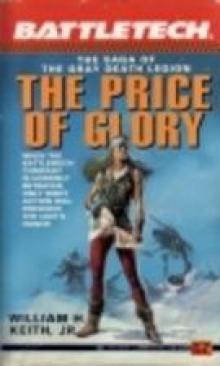 The Price of Glory
The Price of Glory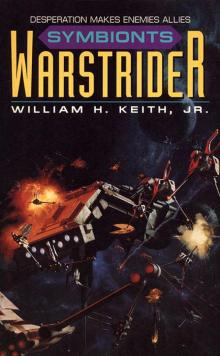 Symbionts
Symbionts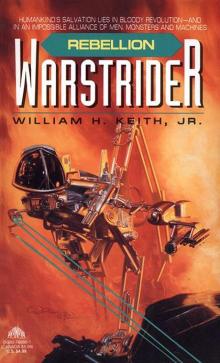 Rebellion
Rebellion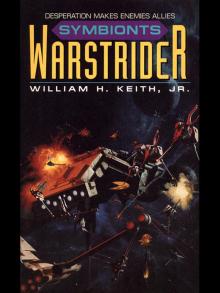 Warstrider 04 - Symbionts
Warstrider 04 - Symbionts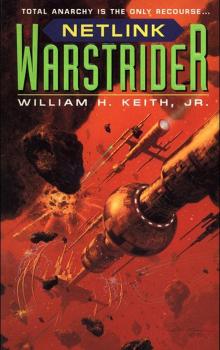 Netlink
Netlink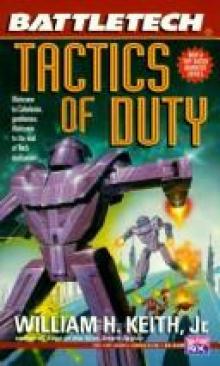 Tactics of Duty
Tactics of Duty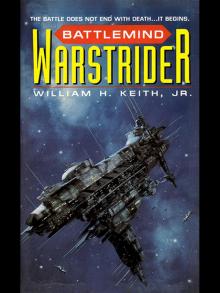 Warstrider 06 - Battlemind
Warstrider 06 - Battlemind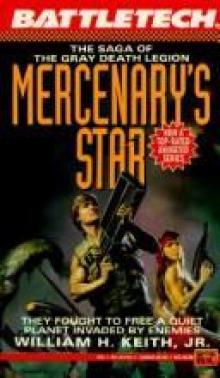 Mercenary's Star
Mercenary's Star Battlemind
Battlemind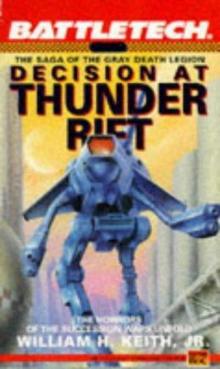 Decision at Thunder Rift
Decision at Thunder Rift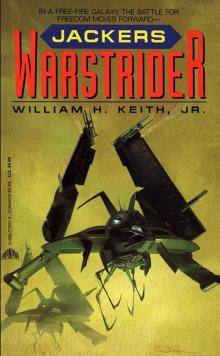 Jackers
Jackers Android: Free Fall
Android: Free Fall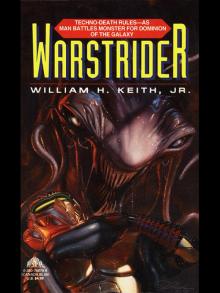 Warstrider 01 - Warstrider
Warstrider 01 - Warstrider Warstrider 05 - Netlink
Warstrider 05 - Netlink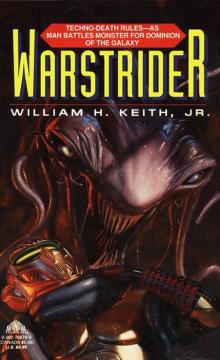 Warstrider
Warstrider